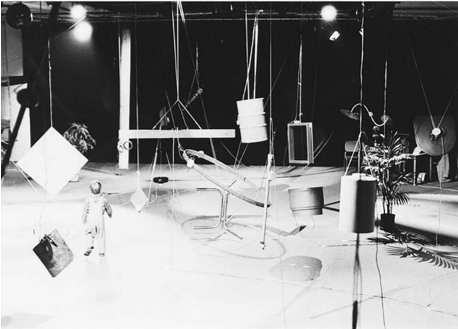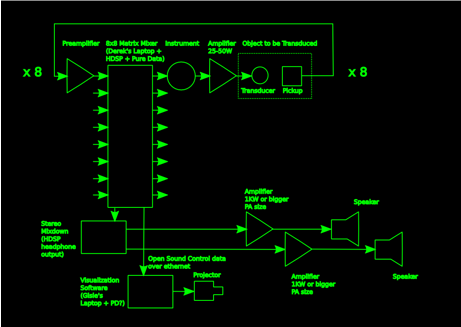Regnskog: Difference between revisions
Macumbista (talk | contribs) |
Macumbista (talk | contribs) |
||
| Line 78: | Line 78: | ||
[[Image:Rainforest_scaled.png]] | [[Image:Rainforest_scaled.png]] | ||
Full size: http://macumbista.net/wp-content/uploads/2010/09/rainforest1.jpg | |||
'''The Hub''' | '''The Hub''' | ||
Revision as of 23:23, 8 September 2010
REGNSKOG
Bergen Kjøtt October 11-17 2010
--
REGNSKOG: a Collaborative Workshop/Performance/Installation in the Spirit of David Tudor
INTRODUCTION: HANDS DIRTY ART
Over the past few years, a strong reaction against the sterile world of laptop sound and video has inspired a new interest in analog processes, or "hands dirty" art in the words of practitioner John Richards. With this renewed analog interest comes a fresh exploration of the pioneers of the electronic arts during the pre-digital era of the 1960s and 1970s. Artists and inventors such as Nam June Paik, Steina & Woody Vasulka, Don Buchla, Serge Tcherepnin, Dan Sandin and David Tudor all constructed their own unique instruments long before similar tools became commercially available or freely downloadable--and often through a long, rigorous process of self-education in electronics.
DAVID TUDOR'S RAINFOREST
David Tudor, in particular, has become the focus of intense interest (c.f. Leonardo Music Journal 14, 2004). His transformation from John Cage's concert pianist to an electronic performer and autodidact engineer in his own right is archetypal for the contemporary media artist, who also must oscillate between the creative and the learning processes. His work "Rainforest" also stands out as an exemplary model of the collaborative process within a technically defined, yet socially open system.
"Rainforest" used a series of transducers to play prerecorded and live sounds through various resonant metal objects suspended by wires in the performance space. It was also conceived as a workshop, involving different musicians and artists in a collaborative setting, each contributing their own sounds, ideas and energies to the performances, which often lasted four or five hours! A complex mixer system allowed the sounds coming from one resonant object to be directed through another, spawning chaotic generations of new sound patterns. The sounds played could be heard through loudspeakers as well as the objects themselves, however they could also be physically felt by touching the objects. Tudor was especially interested in two audiences: children and the blind.
REGNSKOG
"Regnskog" is conceived as a contemporary re-interpretation of "Rainforest" as a workshop, performance and public installation. In the spirit of Tudor's work, much of the equipment and materials will be built by the participants/performers themselves.
BACKGROUND READING
Bill Viola-David Tudor: The Delicate Art of Falling(Leonardo Music 14)
John Driscoll and Matt Rogalsky-David Tudor’s Rainforest: An Evolving Exploration of Resonance(Leonardo Music 14)
http://macumbista.net/wp-content/uploads/2010/09/tudor_rainforest.zip
--
PARTICIPANTS
Harald Fetveit, Oslo
Signe Lidèn, Bergen
Ryan Jordan, London
Derek Holzer, Berlin
Julien Ottavi, Nantes
John Hegre, Bergen
Jørgen Træen, Bergen
Gisle Frøysland, Bergen
LOCATION
Bergen Kjøtt is an old meat factory turned into artist space. It contains artist studios, music studios (Duper), rehearsal rooms, architects, designers and more. It's all kept raw and factory-like. Here's some images of the room where we'll be working:
SCHEDULE
October 11-15 workshop
October 15-16 open installation/performance sessions
- - Friday evening
- - Saturday afternoon
- - Saturday evening
TECH OVERVIEW
Here is a graphical overview of the signal flow of Regnskog:
Full size: http://macumbista.net/wp-content/uploads/2010/09/regnskogsvg.png
Original Tudor Rainforest diagram:
Full size: http://macumbista.net/wp-content/uploads/2010/09/rainforest1.jpg
The Hub
The central "hub" of the installation will be an 8x8 matrix mixer, built in Pure Data using a Hammerfall HDSP soundcard as interface. This will allow the sound from any object to be sent to any of the players for processing. The status of the matrix mixer will also be sent via OSC to Gisle, who will visualize this (also in Pd/GEM?).
Per Channel Equipment
As shown in the diagram above, each channel will require one of the following things. There are 8 channels in total.
- Preamp: a simple, low power circuit to amplify the sound from the pickups to line level before entering the matrix mixer. (Derek can construct/order these)
- Instrument: that's where the players come in. Each of you should bring or construct some sort of instrument capable of taking the signal from the matrix mixer and processing or manipulating it in some way. Simple transformations could be filtering/equalizing. More complex processing is up to you!
- Amplifier (50W): this amp drivers the transducers. A power rating of 50W should cover most of the transducers used.
- Transducer: there are many kinds of transducers (E.g. Vibro motor - http://www.seas.no/ , Tactile transducer comparison - http://www.baudline.com/erik/bass/tactile_report.html, Visaton Principles of exciter technology - http://www.visaton.de/downloads/pdf/visaton_exciter_principles.pdf). It would be good to know what kind of transducers the participants can bring. Derek may order a set of matching transducers besides: Visaton VS-EX60S-8 Loudspeaker exciter [25W average power/40W max power, 8 Ohm, 58x58x20, approx EUR 15 each @ 10 pieces] (http://www.visaton.de/en/industrie/koerperschall/ex60s_8.html) ...I just noticed these don't work well for magnetic material because of the internal magnet... maybe go with Rolen Star Audio Transducers (full range but easy to blow) or SinusLive Bass Pumps (low frequencies only but very robust) instead...[D]
- Pickup: simple piezoelectric "contact mic" pickup most likely. There are many other kinds of pickups and participants are encouraged to bring and experiment with others. Derek will bring a bunch of piezos.
General Equipment
Besides these things, we will also require the following elements in the space:
- Stereo PA: a stereo mixdown of the matrix mixer will be available from the HDSP headphone output. So we will need a basic stereo PA. Keep in mind that this is mostly for a general room sound, and that visitors are encouraged to experience the sounds directly from the objects by touch and hearing. 1KiloWatt of power per channel is definitely overkill, it will depend on the space and how much rooom sound we want...
- Video projection system: the status of the matrix will be sent by OSC to Gisle's PD patch, which will visualize it and send it to the data projector. Other suggestions (from Gisle?) include:
- - what can be found of old crt TVs
- - 1 Edirol V-4 and a couple of older mixers
- - a selection of wi-fi and wired cameras
Other considerations:
- Lighting: for each object/performer
- Suspension system: the objects will be suspended from the ceiling with metal cable, so we will need to figure out exactly how this can be done in the space
- Lots of cable!!!
TECH NEEDS
What do we need?
- Equipment listed above
- Scrap metal (Piksel identifies good spots for scrap harvesting on beforehand)
- Car for picking up stuff (Piksel rents)
- Each participant flown in from the EU brings a bottle of some Spirituous from the Duty Free (you know who you are...)
- Local Bergen volunteer to do photo/video documentation (paid perhaps in above-mentioned "Spirituous"...)
What can you provide?
Don't be shy!!!! ;-)
- Harald:
- Signe:
- Ryan:
- Derek:
- - HDSP + laptop
- - piezo pickups
- - preamps
- - transducers
- Julien:
- John:
- Jørgen:
- Gisle:
- - laptop/PC running PD+MøB
- - 8x16 matrix switcher for composite video controlled by PC
- - 1 Blaupunkt & Panasonic video mixers (good old stuff)
- - a selection of cheap wi-fi and wired cameras (composite)
- Piksel:
- - 1 projector
- - 1 6 chn audio mixer
- - 10 soldering sets
- - Drills
- - Electric saws
PLANNING
Brainstorm area...


